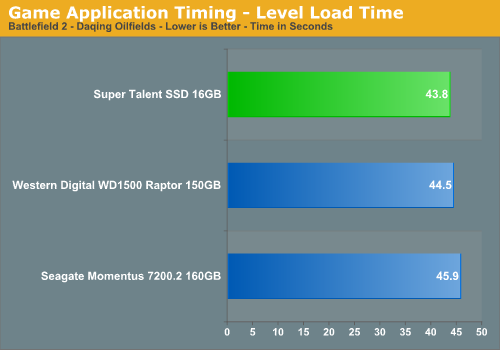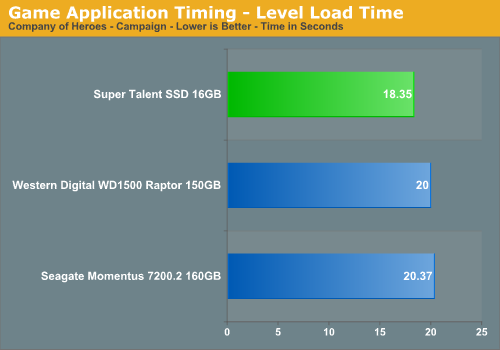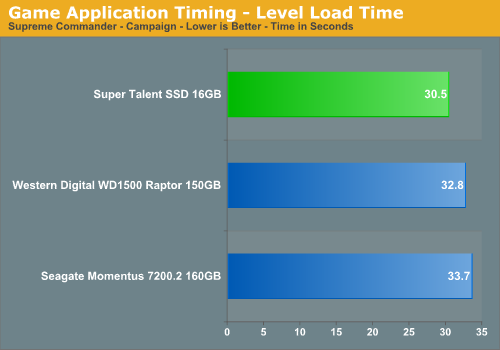Super Talent SSD: 16GB of Solid State Goodness
by Gary Key on May 7, 2007 4:00 AM EST- Posted in
- Storage
Actual Application Times - Gaming
Our application benchmarks are designed to show application performance results with times being reported in seconds, with lower scores being better. While these tests will show differences between the drives it is important to understand we are not measuring the synthetic performance of the hard drive but how well our platform performs with each individual drive. The performance of a drive is an integral part of the computer platform but other factors such as memory, CPU, core logic, and even driver choice can play a major role in determining how well the drive performs in any given task.
Game Level Load
Our tests center on the actual loading of a playable level within our game selections. It is obvious this drive is not intended to be used in gaming systems and we debated on even including these results. However, for game level loads the burst/sustained read speed and access time of a drive is very important. Considering Solid State Drives excel in low access (latency) times we thought it would be interesting to see how well this drive performed in our game tests.
The Battlefield 2 test measures the time it takes to load the Daqing Oilfields level. Our application timer begins when the start single player icon is initiated and ends when the join game icon is visible.

This is one of the more demanding game level load times we test and the Super Talent drive scores first although the margin is minimal. We fully expect the faster consumer level SSD products to improve upon these scores. After several hours of game play we could tell a slight difference between the drives in this test. The SSD product always seemed to load the levels in a smoother manner than our two hard disks, although it was difficult to determine any actual speed differences.
The Company of Heroes test measures the time it takes to load the first campaign level. Our application timer begins when the start single player icon is initiated and ends when the join game icon is visible.

Once again we see a minimal difference between our drives but the Super Talent drive is about 8% faster at loading this particular level. In repeated testing it was difficult to discern the differences between the drive setups but when compared to the Raptor the Super Talent drive is eerily quiet while playing the game. It took a little time to adjust to the acoustic differences not to mention our overall case temperatures being 3C lower after an hour of testing.
Our Supreme Commander test measures the time it takes to load the first campaign level. Our application timer begins when the start single player icon is initiated and ends when the join game icon is visible.

In our final game test the Super Talent drive is around 7% quicker at loading this particular campaign. We did not notice any issues throughout the full campaign scenario and as in the Battlefield 2 tests, the loading of the cut scenes and actual game levels was smoother although we did not perceive any differences in performance.
Our application benchmarks are designed to show application performance results with times being reported in seconds, with lower scores being better. While these tests will show differences between the drives it is important to understand we are not measuring the synthetic performance of the hard drive but how well our platform performs with each individual drive. The performance of a drive is an integral part of the computer platform but other factors such as memory, CPU, core logic, and even driver choice can play a major role in determining how well the drive performs in any given task.
Game Level Load
Our tests center on the actual loading of a playable level within our game selections. It is obvious this drive is not intended to be used in gaming systems and we debated on even including these results. However, for game level loads the burst/sustained read speed and access time of a drive is very important. Considering Solid State Drives excel in low access (latency) times we thought it would be interesting to see how well this drive performed in our game tests.
The Battlefield 2 test measures the time it takes to load the Daqing Oilfields level. Our application timer begins when the start single player icon is initiated and ends when the join game icon is visible.

This is one of the more demanding game level load times we test and the Super Talent drive scores first although the margin is minimal. We fully expect the faster consumer level SSD products to improve upon these scores. After several hours of game play we could tell a slight difference between the drives in this test. The SSD product always seemed to load the levels in a smoother manner than our two hard disks, although it was difficult to determine any actual speed differences.
The Company of Heroes test measures the time it takes to load the first campaign level. Our application timer begins when the start single player icon is initiated and ends when the join game icon is visible.

Once again we see a minimal difference between our drives but the Super Talent drive is about 8% faster at loading this particular level. In repeated testing it was difficult to discern the differences between the drive setups but when compared to the Raptor the Super Talent drive is eerily quiet while playing the game. It took a little time to adjust to the acoustic differences not to mention our overall case temperatures being 3C lower after an hour of testing.
Our Supreme Commander test measures the time it takes to load the first campaign level. Our application timer begins when the start single player icon is initiated and ends when the join game icon is visible.

In our final game test the Super Talent drive is around 7% quicker at loading this particular campaign. We did not notice any issues throughout the full campaign scenario and as in the Battlefield 2 tests, the loading of the cut scenes and actual game levels was smoother although we did not perceive any differences in performance.










44 Comments
View All Comments
JarredWalton - Monday, May 7, 2007 - link
The 100,000 writes is per sector (or whatever the flash block sizes are) of the drive, so even if you're generating thousands of writes per day if the writes are all going to different blocks it becomes much less of an issue. That's what the "proprietary wear leveling algorithms along with built in EDD/EDC functions to ensure excellent data integrity over the course of the drive's lifespan" are supposed to address.Unless you are intentionally rewriting a single location repeatedly, I don't doubt that the drives can last 10 years. Considering I have a lot of normal hard drives fail within five years, that's not too bad. Besides, with the rate of progress it's likely that in the future SSDs will get replaced every couple of years just like today's HDDs.
PandaBear - Thursday, May 10, 2007 - link
With wear leveling, it doesn't matter where you write, it is internally mapped to different physical location each time, so it is 100k write per sector x # of sectors = total # of write you can get out of the entire drive.In this case, a bigger drive buy you more than just space, it buys you extra blocks/sectors that it can cycle through and reduce the wear on every single drives.
Reflex - Monday, May 7, 2007 - link
[quote]That's what the "proprietary wear leveling algorithms along with built in EDD/EDC functions to ensure excellent data integrity over the course of the drive's lifespan" are supposed to address.[/quote]Just to address this specifically, there is no such thing as a 'standard wear leveling algorithm', every flash producer has thier own method of wear leveling, so by default they are all proprietary. I am relatively certain that this company has not come up with something so revolutionary that it would essentially change the entire market as you seem to be implying, if they have I am pretty certain these flash chips would be the industry standard by now. Furthermore, were it any more advanced than the competition, it would not be advertised with a 100k write limitation when the industry standard is 250k writes.
Reflex - Monday, May 7, 2007 - link
I am very aware of how it works. However write operations can happen across several sectors. Once again, consider the market these are intended for. You will NOT get ten years out of one on a typical workstation, it simply will not happen. You will get at least a decade out of one as part of a cash register, assembly line robot, or other industrial/embedded purpose, which is what their statement is all about.You are likely to get one to two years out of one of these, tops. Furthermore, when it fails it will be sudden, and you will not be able to recover your data through conventional means.
I highly suggest you test this before you reccomend your readers to use these things as a main drive. I have tested it extensively myself as part of my job. My email is in my profile if you feel the urge to contact me about this.